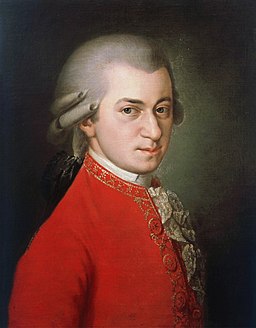This is part 2 of a two-part series on the life of Wolfgang Amadeus Mozart. Read part 1 here.
Church works and Idomeneo
Mozart’s desire to not stay in Salzburg had not diminished, but his need for employment and income won out and he returned in 1779. There, Mozart composed a series of church works, as well as another opera for Munich, Idomeneo.
Idomeneo (1781)
- Accogli, o re Del Mar
- D’Oreste, d’Ajace
- Fuor del mar ho un mar in seno
- Ha vinto Amore
- Idol mio, se ritroso
- Il padre adorato ritrovo
- No, la morte io non pavento
- Non ho colpa, e mi condanni
- Padre, germani, addio
- Se colà ne’ fati è scritto
- Se il padre perdei
- Se il tuo duol
- Torna la pace al core
- Tutte nel cor vi sento
- Vedrommi intorno l’ombra dolente
- Zeffiretti lusinghieri
Although Mozart had an opportunity to perform outside the court for Emperor Joseph II, he was largely kept under wrap and control by Archbishop von Colloredo. Mozart was unhappy with his treatment, and there was bad chemistry between the two men. Ultimately, Mozart resigned his position. Initially the resignation was refused by the Archbishop, but eventually, it was accepted and Mozart was rather unceremoniously shown the door.
Mozart set out for Vienna, where he taught, wrote music, and performed. In 1781 he began working on Die Entführung aus dem Serail.
From the IPA Source database, Die Entführung aus dem Serail (1782):
- Ach, ich liebte, war so glücklich
- Durch Zärtlichkeit und Schmeicheln
- Frisch zum Kampfe
- Hier soll ich dich denn sehen
- Ich baue ganz auf deine Stärke
- In Mohrenland gefangen war
- Martern aller Arten
- O wie ängstlich, o wie feurig
- O! wie will ich triumphiren
- Solche hergelaufne Laffen
- Traurigkeit ward mir zum Lose
- Welche Wonne, welche Lust
- Wenn der Freude Tränen fliessen
- Wer ein Liebchen hat gefunden
Marriage and Fellow Composer Influence
In 1782 Mozart began courting Constanze, a daughter of the Weber family, with whom he was lodging. They were married later that year. The Mozarts had six children. Sadly only two of their children survived infancy.
Gottfried van Swieten, a diplomat, librarian, and government official owned many manuscripts of Baroque masters. As such, Mozart became very familiar with the work of Johann Sebastian Bach and Georg Friedrich Händel. It is said that this influenced Mozart in his creation of Die Zauberflöte (The Magic Flute).
Die Zauberflöte (1791)
- Ach, ich fühl’s
- Alles fühlt der Liebe Freuden
- Bei Männern, welche Liebe fühlen
- Der Hölle Rache
- Der Vogelfänger bin ich ja
- Dies Bildnis ist bezaubernd schon
- Ein Mädchen oder Weibchen
- In diesen heil’gen Hallen
- O Isis und Osiris
- O zitt’re nicht, mein lieber Sohn
- Papageno’s Suicide Scene
- Papageno-Papagena Duet
Mozart met Joseph Haydn in Vienna about 1784, and they became friends. They occasionally performed in impromptu string quartet concerts. Mozart dedicated six quartets to Haydn; some have the opinion that these quartets are a response to Haydn’s Opus 33.
During this time, Mozart did a great deal of performing, sometimes in unconventional venues. He and Constanze embraced a fancier lifestyle, with a more expensive apartment, a fortepiano, and even a billiard table. They sent their son to boarding school, kept servants, and didn’t save any money for future lean times.
While the opera Die Entführung aus dem Serail was successful, Mozart did little additional opera composition beyond Der Schauspieldirecktor, focusing instead on performing as a piano soloist and composer of concertos.
Die Entführung aus dem Serail (1782)
- Ach, ich liebte, war so glücklich
- Durch Zärtlichkeit und Schmeicheln
- Frisch zum Kampfe
- Hier soll ich dich denn sehen
- Ich baue ganz auf deine Stärke
- In Mohrenland gefangen war
- Martern aller Arten
- O wie ängstlich, o wie feurig
- O! wie will ich triumphiren
- Solche hergelaufne Laffen
- Traurigkeit ward mir zum Lose
- Welche Wonne, welche Lust
- Wenn der Freude Tränen fliessen
- Wer ein Liebchen hat gefunden
Der Schauspieldirecktor (1786)
- Bester Jüngling
- Da schlägt die Abshiedsstunde
- Ich bin die erste Sängerin
- Jeder Künstler strebt nach Ehre
In late 1786, Mozart began his collaboration with librettist Lorenzo da Ponte. Le nozze di Figaro, Don Giovanni, and Cosí fan tutte were products of this famed partnership. Read our blog post about da Ponte to learn more.
In 1787, Mozart was appointed Chamber Composer by Emperor Joseph II. Although the income was modest, it was steady and helped Mozart and his family when their finances began to dwindle. It is said that the Emperor appointed Mozart to this role in an attempt to keep him from departing Vienna.
Soon after, Mozart and his family moved to the suburb of Alsergrund. They were intending to save money by making this move, but their financial situation continued to deteriorate. Soon Mozart was borrowing money from friends, as well as traveling to locations such as Leipzig, Dresden, Berlin, and Frankfurt with the hope of earning some money to improve his family’s situation.
Last operas, last days
Slowly, Mozart’s financial situation began to improve. He began repaying debts. Work began picking up for him. Mozart composed Die Zauberflöte (The Magic Flute) and it received a great amount of positive feedback. Mozart’s final opera was La clemenza di Tito, during which he sadly became ill with his final illness.
Die Zauberflöte (1791)
- Ach, ich fühl’s
- Alles fühlt der Liebe Freuden
- Bei Männern, welche Liebe fühlen
- Der Hölle Rache
- Der Vogelfänger bin ich ja
- Dies Bildnis ist bezaubernd schon
- Ein Mädchen oder Weibchen
- In diesen heil’gen Hallen
- O Isis und Osiris
- O zitt’re nicht, mein lieber Sohn
- Papageno’s Suicide Scene
- Papageno-Papagena Duet
La clemenza di Tito (1791)
- Ah, se fosse intorno al trono
- Deh per questo istante solo
- Deh se piacer mi vuoi
- Del più sublime soglio
- Ma che giorno e mai questo
- Non piu di fiori
- Parto, ma tu, ben mio
- S’altro che lacrime
- Se all’impero, amici Dei
- Tardi s’avvede d’un tradimento
- Torna di Tito a lato
- Tu fosti tradito
When Mozart was gravely ill and confined to bed, he labored to complete his famous Requiem Mass. There are accounts of him dictating passages to Franz Xaver Süssmayr, but there is insufficient evidence to support this claim.
The Requiem Mass – Mozart’s Complete Text
The cause of Mozart’s death at age 35 is officially listed as “severe miliary fever,” but many of have speculated on what his final illness may have been, including strep infection, influenza, and even mercury poisoning. He was buried in a common grave, which at the time and in Vienna did not mean a mass grave but rather a commoner’s grave (as opposed to an aristocrat’s grave).
While he may have been buried as a commoner, his standing with the public was much greater. Memorial services and concerts were held and widely attended. Mozart’s music and popularity actually increased greatly in the period immediately after his death.
Did you miss the first part of this two-part series? Read part 1 here.

